‘Winona’
Pasture cropping for the way to health
A REGENERATIVE AGRICULTURE CASE STUDY FROM THE NSW CENTRAL TABLELANDS
Colin Seis faced adversity and then struck ‘gold’ by developing a new way to look after the land and his bottom line – building tonnes of soil along the way. Winona was one of the first Soils For Life case studies in 2012. Click here for information about our revisit in 2020.
Winona
FARM FACTS
ENTERPRISE: Sheep. Crops. Native Grass Seed. Kelpie Dogs.
PROPERTY SIZE: 840 hectares
AVERAGE ANNUAL RAINFALL: 650 mm
ELEVATION: 460-580m
SOIL: Brown Chromosol (an abrupt increase in texture between the topsoil and subsoil which is not strongly acid or sodic).
AGROCLIMATIC REGION: Temperature, sub-humid.
MOTIVATION FOR CHANGE: Loss after major bushfire necessitating establishment of a low-input agricultural system
INNOVATIONS
- Developing and implementing ‘pasture cropping’
- Time-controlled rotational grazing
- ‘Vertical Stacking’ of enterprises – cropping, native grass seed, sheep wool and meat
- Innovations commenced: Time controlled grazing 1989/Pasture cropping 1993
KEY RESULTS
- Annual input costs reduced by over $120,000
- Soil carbon increased by 203% in 10 years
- Delivering three production lines from each paddock
- Improved wool quality
The Winona Story
The management of Winona from 1930 to 1980 turned out to be an ecological disaster. Loss of land to salinity, declining soil quality, dead and dying trees, insect attack, fungal and animal diseases, plus the high cost of fertilisers, herbicides and other inputs showed the suffering of an unhealthy system. In 1979 a devastating bushfire left no choice but to change the way things were done.
In developing ‘Pasture Cropping’ Colin Seis found a way to work his pastures, crops and sheep together and healed his land. Now, Winona produces similar volumes of wool and grain to that achieved under previous management methods, but annual costs have decreased by over $120,000 and the condition of the land is improving, not degrading.
By applying regenerative forms of cropping and grazing, Colin has achieved a 203% increase in soil carbon in just ten years. The vast majority of the soil carbon is highly stable (non-labile), meaning it is significantly less subject to degradation, and carbon is being built and measured to a depth of 500mm.
In addition to being able to pass on a productive and sustainable farm to the next generation, Colin feels a well-deserved sense of achievement at having developed an innovative farming method that is being adopted by thousands of other farmers in similar climates and soil landscapes all over the world.
How it all began
The Seis family has farmed at Winona since the 1860s. Colin’s great grandfather initially selected a small allotment to which other allotments were added over the years to eventually form the current 840 hectares. Colin took over management of the Winona from his father in the 1970s, and now, Colin’s son Nick performs much of the day-to-day management.
Ranging from valley floors and gentle slopes rising to granite outcrops on hilltops and ridges, the predominant soils on Winona are well-drained coarse and fine sands derived from granite. There are yellow sodic (high sodium) soils along drainage lines and euchrozems (deep red clay loams) that developed on an area of basalt at the southern end of the property.
When the Seis family selected the first allotment in 1860, survey reports described the area as woodland, suggesting that the land cover was grassland with scattered trees. It is likely that there were over 100 native grass, forb and herb species, with the grassland dominated by kangaroo grass (Themeda australis). While little tree clearing was probably required to develop the land for farming, the change in management soon led to widespread tree regeneration. Title deeds dated 1906 record the presence of stringybark saplings. Colin’s father recalled considerable ring-barking occurring when he was a boy in the 1920s, indeed, one paddock is still referred to today by the name of the man employed at the time to ring-bark trees. Colin’s father also recalled that there were sparsely scattered large trees within the saplings. The large trees were retained and some remain today.
From the 1930s to 1980, the farm was used for wheat, oats, wool and sheep production. Pastures of introduced grasses, mostly annual species (sub clover, rye grass, small areas of lucerne), were established. Set or continuous stock grazing practices were used. Crops were sown every three to five years, depending on soil moisture, by ploughing and working the soil up to five times. Crop yields during this period were good, with yields of over three tonnes a hectare being achieved.

Left: Grazing on Winona in 1938. Right: Grazing on Winona in 2009.
Declining health
Associated with these management practices the soils were showing excesses of aluminium, iron and sodium. Soil carbon levels were around 1% in the 0-10cm range with observed inefficient nutrient cycling. To sustain agricultural productivity it was necessary to apply high rates fertiliser to correct phosphorus, molybdenum and calcium deficiencies.
Colin recalls, “While superphosphate was cheap and subsidised by government during the 1950s and 1960s this high input method was very productive, but at great ecological cost such as declining soil health, soil carbon loss, soil structure decline, saline areas and dysfunctional landscape”.
He notes, “As superphosphate became more expensive and the government subsidy removed this high input system could no longer be afforded. The high cost of fertilising pasture and farm inputs was around $121,000 annually – in 2011 dollars, including wages”.
No choice
In 1979 a major bushfire resulted in the loss of over 3000 sheep and most of the farm infrastructure – house, sheds and fencing. The lack of income prevented re-establishing the previous high input cost cropping method. So, after the fire, Colin started looking for a low input agricultural system. He set about understanding the ecological function of the landscape he had inherited and had managed using practices learned from his father. Faced with the challenge of matching inputs to outputs, Colin began exploring alternatives to the traditional farming system and the likely impacts on his farm’s economics.
Inappropriate grazing techniques have done major damage to Australia’s grasslands and rangelands over the last 200 years. Animals can be beneficial, if they are grazed well.
He realised that native grassland did not require high levels of phosphorus and started to develop methods that would stimulate seedling recruitment of native grass species. He sought to restore Winona to native grassland that did not require inputs like superphosphate and would function in an ecologically sound manner. Colin summarises, “If you get out of the way and let nature fix it, it works better and is much easier”.
Colin notes that tradition was arguably the greatest impediment to change. In spite of requesting assistance from scientific and research organisations, they were not interested in developing a pasture cropping management system. Representatives of these organisations told Colin that it was impossible to grow crops in this manner.
Instead, over a period of 20 years Colin developed the pasture cropping technique by trial and error on Winona. He has spent much of his time perfecting this technique and can now grow many different types of winter and summer growing crops, without destroying the perennial pasture base.
Pasture cropping on Winona
Colin originally started time control grazing in 1989 to better manage pastures, but it was not until he and Daryl Cluff developed pasture cropping in 1993 that Colin saw dramatic improvement in the regeneration of native perennial pasture species.
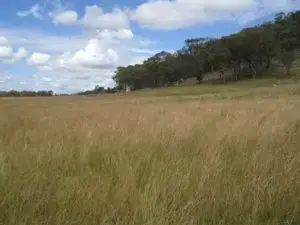
Native pastures on Winona are grazed by sheep and, when dormant, direct drilled with crops.
Colin now sows commercial crops into the dominant pasture by direct drilling to minimise soil disturbance. Sheep are used to prepare paddocks to pasture crop and crops are sown, usually with no herbicide and 70% less fertiliser than conventional methods. Only relatively small amounts of liquid organic fertiliser are added at the time of sowing, using the same machine, so that tractor costs and soil compaction are minimised.
Livestock are an intrinsic part of Colin’s pasture cropping system on Winona. Before sowing, when perennial pasture species are dormant, short term time-control grazing with a large mob of sheep (100-150 a hectare) is used to graze and trample perennial pasture down to a height of around 100mm. This practice prepares the paddock for cropping by reducing the starting biomass and physically breaking down weeds, creating a litter and mulch layer and adding nutrients from manure and urine.
Sheep can lightly graze the growing grain crop after it has become established but before it begins to develop seed. Once the crop is harvested sheep are reintroduced for a short period to take advantage of the native pasture that has been re-growing while the crop was maturing. Grazing tolerant native grass species such as red grass (Bothriochloa macra) and spear grass (Austrostipa spp) are gradually being replaced by more productive species such as warrego summer-grass (Paspalidium spp) and wallaby grass (Austrodanthonia spp). Significant areas of winter active species such as common wheat grass (Elymus scaber) and weeping grass (Microlaena stipoides) are returning.
Pasture cropping enables integration of sheep and crop production, optimising production of both while minimising chemical inputs and machinery use and improving soil structure and fertility.
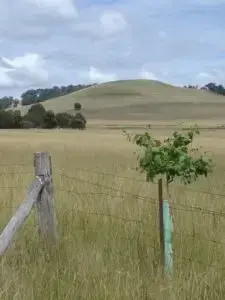 Sheep are managed in two main mobs of 2000 head and rotated around 75 paddocks in a time-control rotational grazing technique. Introducing time-control grazing necessitated a denser pattern of fencing to increase the number of paddocks from 10 to 75. A central laneway provides an efficient way to move sheep around the property. Over 70 small dams supply stock water as there are no creeksor rivers on Winona. These dams have high water levels and are maintained mainly through lateral underground flow. The combination of the soil type and maintaining a complete groundcover ensures that all rainfall infiltrates.
Sheep are managed in two main mobs of 2000 head and rotated around 75 paddocks in a time-control rotational grazing technique. Introducing time-control grazing necessitated a denser pattern of fencing to increase the number of paddocks from 10 to 75. A central laneway provides an efficient way to move sheep around the property. Over 70 small dams supply stock water as there are no creeksor rivers on Winona. These dams have high water levels and are maintained mainly through lateral underground flow. The combination of the soil type and maintaining a complete groundcover ensures that all rainfall infiltrates.
Colin recognises that trees provide stock shelter and that it is essential to replace the old paddock trees that are nearing the end of their life span. He has planted over 2000 single paddock trees, aiming to restore the original 1860s cover, estimated to be about two trees a hectare. As they establish, the single trees are protected from stock with guards. In addition, around 15,000 local native trees and shrubs have been planted in belts to form wildlife corridors and to link areas of remnant native vegetation.
Colin is deservedly proud of the technique he developed, noting its strengths, “With pasture cropping it is now possible to produce an annual crop like wheat and a perennial grain crop for human consumption off the same area within a twelve month period. Added to this is the grazing value of sheep meat and wool as well as native grass seed and carbon sequestration”.
“I believe that this technique of using ‘vertical stacking’ of enterprises on the same area over the same time period has potential for addressing world food shortages into the future.”
Vertical stacking of enterprises
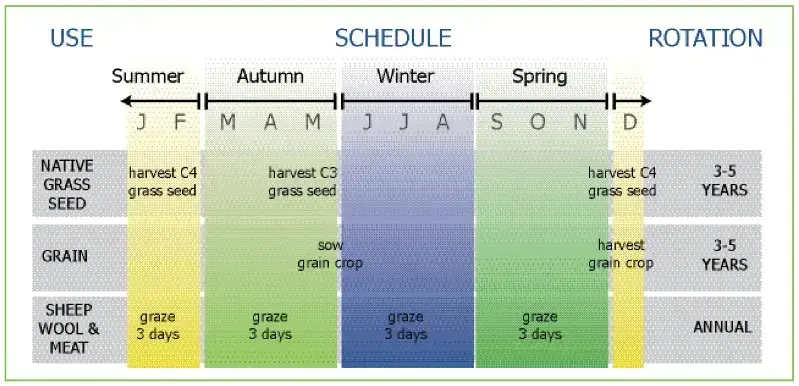
Vertical stacking enables three uses of the native grassland in each paddock – native seed harvesting, grain cropping (oats and wheat) and grazing sheep for wool and meat. The three land uses are rotated seasonally, annually and every 3-5 years, depending of the prevailing seasonal conditions such as soil moisture, rainfall and temperature.
Native grass seed is harvested in summer (C4 species) and autumn (C3 species). Grain crops are direct drilled into the winter dormant native pasture at the end of autumn and harvested in summer. Sheep graze each paddock once each season, approximately 3 days every 90 days, the highest frequency of the land use rotations.
Health restored, benefits accrued
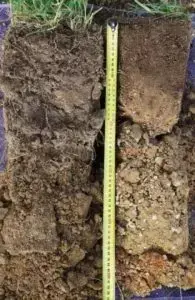
Soil from a conventionally grazed and cropped paddock (right) and from a time-controlled rotationally grazed and pasture cropped paddock (left) which contains significantly more microbial life, soil carbon and subsequently greater water holding capacity.
Extensive soil testing on Winona has shown that eliminating all cultivation other than the direct drilling for pasture cropping, together with rotational grazing, has enabled dramatic improvements in soil condition. Soil carbon has increased by 203% to 90 tonnes a hectare over a ten-year period. This equates to storage of around 170 tonnes of CO2 (equivalent) a hectare.
Seventy-eight per cent of newly sequestered carbon is in the humic fraction of the soil 1. This is non-labile, therefore much more stable and significantly less subject to degradation.
All soil nutrients have increased by an average of 172% in available and total amounts, except for aluminium, iron and sodium, which have decreased. Compared to regular cropping, pasture cropping soils show an increase in actinomycete (bacteria which have a role in decomposition of organic materials) and fungal abundance consistent with less disturbance and/or with greater perennial basal cover and litter cover. These impressive results have been validated through a paired site analysis by Sydney University and CSIRO/Department of Primary Industries 2.
Soil carbon levels on Winona
Increase in soil microbial numbers and species diversity has resulted in better nutrient cycling and greater potential for increasing soil carbon.
| Depth | Soil Carbon Level |
|---|---|
| 0-10cm | 2.65% |
| 10-20cm | 1.35% |
| 20-30cm | 1.18% |
| 30-40cm | 0.53% |
| 40-50cm | 0.26% |
Soil tests conducted in September 2010 revealed carbon levels at the various depths as shown in the table.
Colin notes that his landscape has developed a real resilience, with relatively stable production regardless of rainfall. “Over the last ten years, we have experienced five years of above average rainfall and five years below. A new rainfall pattern has emerged that sees 70% of our rain falling in the summer months, whereas before it was closer to 50%. In the poorer years, no ‘drought’ feeding has been required, due to the resilience in the pastures from the improving soil conditions.”
Many biodiversity improvements are apparent since the changes to management of Winona. Vegetation changes are being monitored on six 100 metre long survey lines (transects). Winona was once dominated by annual weeds and the transect counts from 1999 showed 60% weeds and 10% native perennial species in the pasture. Transects now show 80% perennial native species and 5% weeds. Winona is now a diverse, functioning native grassland with over 50 native species.
As Colin points out, this change was created, not with herbicides, but with groundcover. “Providing the conditions for perennial pasture species to thrive will steadily suppress the weeds. Using herbicides can help is some circumstances but can also kill desirable species, such as the perennial pasture species.”
Tree health has improved and the remaining naturally established trees are regenerating.
Monitored bird numbers and diversity includes around 100 species. Sparrows and starlings that were common prior to 1990s are no longer observed on Winona. Few marsupial species were observed prior to 1990s and now marsupial diversity has also increased, including grey kangaroos, swamp and red necked wallabies and wallaroos.
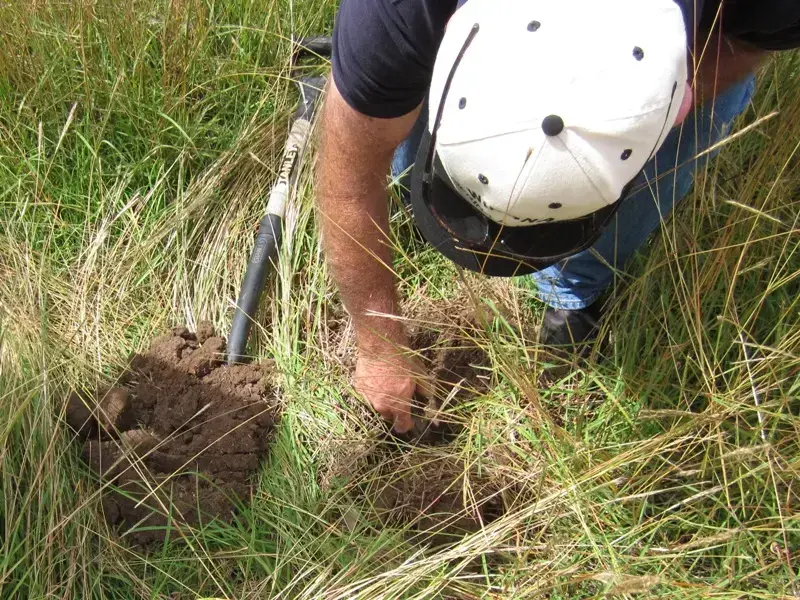
Healthy soils are clearly apparent under the diverse native vegetation cover on Winona.
A large increase of spiders in pastures has delivered a more stable balance to the insect populations and provided biological control of problem insects like red leg earth mite.
Whilst crop production on Winona has remained about the same, averaging two tonnes a hectare but producing up to four tonnes a hectare, the cost of growing the crops has reduced significantly; in the order of $120,000 a year.
Additionally, Winona now produces and sells about one tonne of native grass seed annually to farmers and for landscape rehabilitation. Colin is also investigating the economics of harvesting and marketing of two native grass seeds for human food consumption.
Pasture cropping enables extra grazing of up to six months on Winona’s mixed farm enterprise. No longer having to re-sow pastures saves $100 – $150 a hectare per year.
Wool and sheep production has also remained about the same, however wool tensile strength has improved by 60% and vegetable matter such as burr and seed in the wool has declined by around 70% making both the wool and sheep more valuable.
Colin says that being able to measure and monitor on his farm has been very important, “Carbon and soil nutrients, plant and ground cover transects as well as sheep and crop monitoring has been very beneficial in observing the positive change forward”.
Education is also seen essential to bringing positive change. Colin states, “We require more farmer educators. Farmers should empower themselves with knowledge.” Colin devotes a lot of his own time running courses, workshops and providing training on pasture cropping across the country, encouraging experimentation with or adoption of this innovative technique.
Overall, the development and implementation of pasture cropping has restored the landscape health on Winona. Re-establishing native grasslands through methods working with nature, ensuring ground cover at all times, rather than trying to control it through use of herbicides and fertilisers has delivered its rewards to Colin Seis.
In his words, “As we farm closer to how nature had it originally designed, the easier the workload becomes and the more profitable it can be.”




